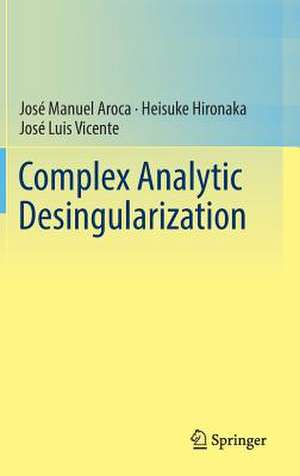Complex Analytic Desingularization
Autor José Manuel Aroca, Heisuke Hironaka, José Luis Vicenteen Limba Engleză Hardback – 14 noi 2018
[From the foreword by B. Teissier] The main ideas of the proof of resolution of singularities of complex-analytic spaces presented here were developed by Heisuke Hironaka in the late 1960s and early 1970s. Since then, a number of proofs, all inspired by Hironaka's general approach, have appeared, the validity of some of them extending beyond the complex analytic case. The proof has now been so streamlined that, although it was seen 50 years ago as one of the most difficult proofs produced by mathematics, it can now be the subject of an advanced university course. Yet, far from being of historical interest only, this long-awaited book will be very rewarding for any mathematician interested in singularity theory. Rather than a proof of a canonical or algorithmic resolution of singularities, what is presented is in fact a masterly study of the infinitely near “worst” singular points of a complex analytic space obtained by successive “permissible” blowing ups and of the way to tame them using certain subspaces of the ambient space. This taming proves by an induction on the dimension that there exist finite sequences of permissible blowing ups at the end of which the worst infinitely near points have disappeared, and this is essentially enough to obtain resolution of singularities. Hironaka’s ideas for resolution of singularities appear here in a purified and geometric form, in part because of the need to overcome the globalization problems appearing in complex analytic geometry.
In addition, the book contains an elegant presentation of all the prerequisites of complex analytic geometry, including basic definitions and theorems needed to follow the development of ideas and proofs. Its epilogue presents the use of similar ideas in the resolution of singularities of complex analytic foliations. This text will be particularly useful and interesting for readers of the younger generation who wish to understand one of the most fundamental results in algebraic and analytic geometry and invent possible extensions and applications of the methods created to prove it.
Preț: 755.11 lei
Preț vechi: 943.89 lei
-20% Nou
Puncte Express: 1133
Preț estimativ în valută:
144.54€ • 157.05$ • 121.49£
144.54€ • 157.05$ • 121.49£
Carte disponibilă
Livrare economică 31 martie-14 aprilie
Livrare express 15-21 martie pentru 38.96 lei
Preluare comenzi: 021 569.72.76
Specificații
ISBN-13: 9784431702184
ISBN-10: 4431702180
Pagini: 330
Ilustrații: XXIX, 330 p. 379 illus.
Dimensiuni: 155 x 235 x 28 mm
Greutate: 0.71 kg
Ediția:1st ed. 2018
Editura: Springer
Colecția Springer
Locul publicării:Tokyo, Japan
ISBN-10: 4431702180
Pagini: 330
Ilustrații: XXIX, 330 p. 379 illus.
Dimensiuni: 155 x 235 x 28 mm
Greutate: 0.71 kg
Ediția:1st ed. 2018
Editura: Springer
Colecția Springer
Locul publicării:Tokyo, Japan
Cuprins
Prologue.- 1 Complex-Analytic Spaces and Elements.- 2 The Weierstrass Preparation Theorem and Its Consequences.- 3 Maximal Contact.- 4 Groves and Polygroves.- 5 The Induction Process.- Epilogue: Singularities of differential equations.- Bibliography.- Index.
Textul de pe ultima copertă
[From the foreword by B. Teissier] The main ideas of the proof of resolution of singularities of complex-analytic spaces presented here were developed by Heisuke Hironaka in the late 1960s and early 1970s. Since then, a number of proofs, all inspired by Hironaka's general approach, have appeared, the validity of some of them extending beyond the complex analytic case. The proof has now been so streamlined that, although it was seen 50 years ago as one of the most difficult proofs produced by mathematics, it can now be the subject of an advanced university course. Yet, far from being of historical interest only, this long-awaited book will be very rewarding for any mathematician interested in singularity theory. Rather than a proof of a canonical or algorithmic resolution of singularities, what is presented is in fact a masterly study of the infinitely near “worst” singular points of a complex analytic space obtained by successive “permissible” blowing ups and of the way to tame them using certain subspaces of the ambient space. This taming proves by an induction on the dimension that there exist finite sequences of permissible blowing ups at the end of which the worst infinitely near points have disappeared, and this is essentially enough to obtain resolution of singularities. Hironaka’s ideas for resolution of singularities appear here in a purified and geometric form, in part because of the need to overcome the globalization problems appearing in complex analytic geometry.
In addition, the book contains an elegant presentation of all the prerequisites of complex analytic geometry, including basic definitions and theorems needed to follow the development of ideas and proofs. Its epilogue presents the use of similar ideas in the resolution of singularities of complex analytic foliations. This text will be particularly useful and interesting for readers of the younger generation who wish to understand one of the most fundamental results in algebraic and analytic geometry and invent possible extensions and applications of the methods created to prove it.
Caracteristici
Presents a complete and self-contained proof of the theorem of desingularization for complex-analytic spaces
Contains an elegant presentation of all the tools of complex-analytic geometry needed to study singularities
Helps upcoming generations of readers understand one of the most fundamental results in algebraic and analytic geometry
Contains an elegant presentation of all the tools of complex-analytic geometry needed to study singularities
Helps upcoming generations of readers understand one of the most fundamental results in algebraic and analytic geometry
